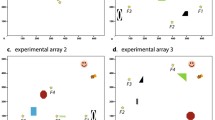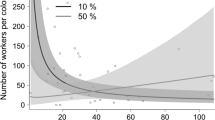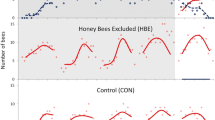Abstract
The patch living rules of a pollinator, the bumblebee Bombus terrestris L., are studied here in the framework of motivational models widely used for parasitoids: The rewarding events found during the foraging process are supposed to increase or decrease suddenly the tendency of the insect to stay in the current patch and therefore to adjust the patch residence time to the patch profitability. The foraging behaviour of these pollinators was observed in two environment types to determine their patch-leaving decisions. The rich environment was composed of male-fertile flowers, offering pollen and nectar, and the poor one of male-sterile flowers, offering little nectar and no pollen. The experimental design consisted of a patch system in which inflorescences were evenly arranged in two rows (1 m distance). Residence times of foragers inside inflorescences and rows were analysed by a Cox proportional hazards model, taking into account recent and past experience acquired during the foraging bout. Most of the results showed a decremental motivational mechanism, that is, a reduction in the residence time on the inflorescence or in the row related to exploitation of flowers within inflorescences and inflorescences within rows These results indicate that bumblebees tend to leave the patch using departure rules similar to those found in parasitoids. The results also provide information on the memory, learning and evaluating capabilities of bumblebees especially when rich and poor environments were compared. The patch-leaving mechanism suggested by this study is consistent with the central place foraging theory.

Similar content being viewed by others
References
Becker RA, Chambers JM, Wilks AR (1988) The new S language. Chapman & Hall, London
Biernaskie JM, Cartar RV, Hurly TA (2002) Risk-averse inflorescence departure in hummingbirds and bumble bees: could plants benefit from variable nectar volumes? Oikos 98:98–104
Cézilly F, Benhamou S (1996) Les stratégies optimales d’approvisionnement. Rev Ecol (Terre Vie) 51:43–86
Charnov ER (1976) Optimal foraging: the marginal value theorem. Theor Popul Biol 9:129–136
Collett D (2003) Modelling survival data in medical research. Chapman & Hall, London
Cox DR (1972) Regression models and life tables. Biometrics 38:67–77
Cresswell JE (1999) The influence of nectar and pollen availability on pollen transfer by individual flowers of oilseed rape (Brassica napus) when pollinated by bumblebees (Bombus lapidarius). J Ecol 87:670–677
Driessen G, Bernstein C (1999) Patch departure mechanisms and optimal host exploitation in an insect parasitoid. J Anim Ecol 68:445–459
Driessen G, Bernstein C, Van Alphen J, Kacelnik A (1995) A count down mechanism for host search in the parasitoid Venturia canescens. J Anim Ecol 64:117–125
Ferdy JB, Smithson A (2002) Geitonogamy in rewarding and unrewarding inflorescences: modelling pollen transfer on actual foraging sequences. Evol Ecol 16:155–175
Goulson D, Stout JC, Langley J, Hughes WOH (2000) Identity and function of scent marks deposited by foraging bumblebees. J Chem Ecol 26:2897–2911
Goulson D, Chapman JW, Hughes WHO (2001) Discrimination of unrewarding flowers by bees; direct detection of reward and use of repellent scent marks. J Insect Behav 14:669–678
Haccou P, Meelis E (1992) Statistical analysis of behavioural data—an approach based on time-structured models. Oxford University Press, Oxford
Haccou P, de Vlas SJ, Van Alphen JJM, Visser ME (1991) Information processing by foragers: effects of intra-patch experience on the leaving tendency of Leptopilina heterotoma. J Anim Ecol 60:93–106
Hemerik L, Driessen G, Haccou P (1993) Effects of intra-patch experiences on patch time, search time and searching efficiency of the parasitoid Leptopilina clavipes. Ecology 62:33–44
Hodges C (1985a) Bumble bee foraging: the threshold departure rule. Ecology 66:179–187
Hodges C (1985b) Bumble bee foraging: energetic consequences of using a threshold departure rule. Ecology 66:188–197
Houston A, McNamara J (1985) A general theory of central place foraging for single-prey loaders. Theor Popul Biol 28:233–262
Iwasa Y (1982) On evolution in changing environments. In: Ito Y (ed) Introduction to social ecology. Tokyo University Press, Tokyo, Japan, pp 87–104
Iwasa Y, Higashi M, Yamamura N (1981) Prey distribution as a factor determining the choice of optimal foraging strategy. Am Nat 117:710–723
Kadmon R, Shmida A (1992) Departure rules used by bees foraging for nectar field test. Evol Ecol 6:142–151
Keasar T, Motro U, Shur Y, Shlida A (1996) Overnight memory retention of foraging skills by bumblebees is imperfect. Anim Behav 52:95–104
Krebs JR, Davies NB (1992) Behavioural ecology: an evolutionary approach. Blackwell, Oxford
Mangel M (1989) Evolution of host selection in parasitoids: does the state of the parasitoid matter? Am Nat 133:688–705
McNamara JM, Houston AI (1985) A simple model of information in the exploitation of a patchily distributed food. Anim Behav 33:553–560
Ohashi K, Yahara T (2002) Visit larger displays but probe proportionally fewer flowers: counterintuitive behaviour of nectar-collecting bumble bees achieves an ideal free distribution. Funct Ecol 16:492–503
Orians GH, Pearson NE (1979) On the theory of central place foraging. In: Horn DJ, Stairs GR, Mitchell RD (eds) Analysis of ecological systems state. Ohio State University Press, Columbus, OH, pp 154–177
Outreman Y, Le Ralec A, Wajnberg E, Pierre JS (2005) Effect of within and among patch experiences on the patch leaving decision rules in insect parasitoids. Behav Ecol Sociobiol 58(2):208–217
Pappers SM, de Jong TJ, Klinkhamer PGL, Meelis E (1999) Effects of nectar content on the number of bumblebee approaches and the length of visitation sequences in Echium vulgare (Boraginaceae). Oikos 87:580–586
Pierre J, Mesquida J, Marilleau R, Pham-Delègue MH, Renard M (1999) Nectar secretion in winter oilseed rape, Brassica napus—quantitative and qualitative variability among 71 genotypes. Plant Breed 118:471–476
Pierre JS, Van Baaren J, Boivin G (2003) Departure rules from the patch in parasitoids: do they achieve a sequential decisional sampling? Behav Ecol Sociobiol 54:147–155
Pleasants JM (1989) Optimal foraging by nectarivores: a test of the marginal value theorem. Am Nat 134:51–71
Plowright C, Cantin-Plante N (1997) Le choix de la direction des trajets entre fleurs des bourdons (Bombus) butineurs. Can Entomol 129:915–925
Pyke GH (1982) Foraging in bumblebees: rule of departure from an inflorescence. Can J Zool 60:417–428
R Development Core Team (2006) R: A language and environment for statistical computing. http://www.R-project.org
Therneau TM, Grambsch PM (2000) Modeling survival data: extending the Cox model. Statistics for biology and health. Springer, Berlin Heidelberg New York
Van Alphen JJM, Bernstein C, Driessen G (2003) Information acquisition and time allocation in insect parasitoids. Trends Ecol Evol 18:81–87
Waage JK (1979) Foraging for patchily distributed hosts by the parasitoid, Nemertis canescens. J Anim Ecol 48:353–371
Wajnberg E, Rosi MC, Colazza S (1999) Genetic variation in patch time allocation in a parasitic wasp. J Anim Ecol 68:121–133
Wajnberg E, Gonsard PA, Tabone E, Curty C, Lezcaano N, Colazza S (2003) A comparative study of patch leaving decision rules in a parasitoid family. J Anim Ecol 72:618–626
Acknowledgement
The authors thank Jean-Pierre Masson for useful discussions concerning the statistical analysis used in this manuscript. They also thank Franck Poirier and Samuel Monvoisin for technical support and Randy Kutcher for reviewing the English. They are indebted to the two anonymous referees of a previous version for their careful revision and useful comments. This work complied with the current laws in France and received financial support from the GIS L Bio, “Projet Pollinisation,” Région Bretagne et Pays de Loire, France.
Author information
Authors and Affiliations
Corresponding author
Additional information
Communicated by M. Giurfa
Rights and permissions
About this article
Cite this article
Lefebvre, D., Pierre, J., Outreman, Y. et al. Patch departure rules in Bumblebees: evidence of a decremental motivational mechanism. Behav Ecol Sociobiol 61, 1707–1715 (2007). https://doi.org/10.1007/s00265-007-0402-6
Received:
Revised:
Accepted:
Published:
Issue Date:
DOI: https://doi.org/10.1007/s00265-007-0402-6




